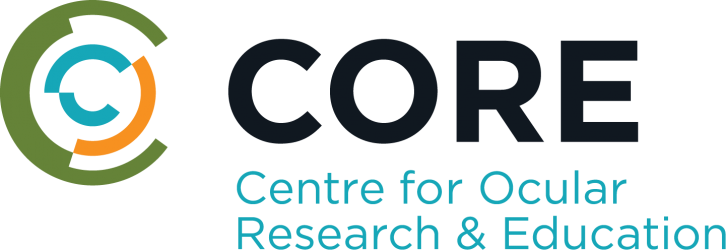Jump to:
Peer-reviewed articles
2025
Wolffsohn,J., Travé-Huarte,S., Stapleton,F,, Downie,L.E., Schulze,M., Guthrie,S., Stahl,U., Wang,M., Craig,J.
Relative importance of tear homeostatic signs for the diagnosis of dry eye disease
The Ocular Surface 2025;36(April):151-155
[ Show Abstract ]
Aim: Disease misdiagnosis is more likely if standardised diagnostic criteria are not used. This study systematically examined the effect on diagnosing dry eye disease (DED), when tests for evaluating tear film homeostasis were included or excluded from a multi-test protocol.
Method: For 1,427 participants across five sites, data for the full suite of diagnostic tests defined in the Tear Film and Ocular Surface Society Dry Eye Workshop II (TFOS DEWS II) Diagnostic Methodology report algorithm were evaluated; diagnostic sensitivity was calculated when individual signs were removed, and when different combinations of signs were required.
Results: Evaluating just one of the three TFOS DEWS II homeostatic signs resulted in between 12.3 % and 36.2 % of patients who met the DED diagnostic criteria not being assigned this diagnosis. While comprehensive ocular surface staining evaluation, comprising of corneal, conjunctival and lid margin staining, in combination with symptoms had the highest sensitivity (87.7 %) of the three markers, the sensitivity dropped to 44.6 % if only corneal staining was evaluated. Omitting either non-invasive tear breakup time or tear osmolarity each dropped the sensitivity by <5 %. The prevalence of DED was substantially reduced if a diagnosis required symptoms and two of the three signs to be present (by 43.7 %–61.2 %) and by 65.9 % if all three signs indicating a loss of tear film homeostasis were required. The outcomes of the analysis did not change significantly across differing severities of DED symptoms.
Conclusions: The TFOS DEWS II diagnostic algorithm of symptoms plus assessing for a tear film (non-invasive tear breakup time or tear osmolarity) and ocular surface sign can be considered a robust and appropriate approach for DED diagnosis.
Wong,S., Woods,J., Schulze,M., Fadel,D., Stahl,U., Jones,L.
Performance of Delefilcon A Daily Disposable Contact Lenses in a Group of Digital Device Users
Clinical Ophthalmology 2025;19(July):2439-2452
[ Show Abstract ]
Purpose: To assess the performance of delefilcon A daily disposable contact lenses (CL) in lens wearers who reported heavy digital device use.
Patients and Methods: This prospective study involved lens wearers who used digital devices ≥ 8 hours per day. Delefilcon A CL were dispensed for 2-weeks, to be worn ≥ 5 days/week, ≥ 13 hours/day, using digital devices as normal. At-home questionnaires rating comfort, dryness, and clarity of vision (0– 100 scale, 100=best) were completed on Days 1, 7, and 14± 1 upon insertion, after 8 hours of device use, and before removal. At the Day 14 visit, participants rated overall comfort, dryness, and vision (0– 100 scale) and completed a 5-point Likert-type scale questionnaire.
Results: Thirty-five participants were eligible, 32 completed (27 females; age: 25.3± 6.3 years). Median at-home ratings for comfort, dryness, and vision were ≥ 85, with no difference between days (all p≥ 0.09). Ratings decreased throughout the day (p≤ 0.005), except comfort (Day 7) and vision (Days 1 and 7), where ratings before removal were similar to 8 hours of device use (p≥ 0.014). After 2-weeks, median (range) overall ratings for comfort, dryness, and vision were 96 (70– 100), 93 (50– 100), and 95 (75– 100), respectively. Most agreed the CL performed well, providing good comfort (91%) and vision all-day-long (94%), and did not have dryness with device use (69%). When devices were used ≥ 8 hours, most felt the CL performed well (84%), were satisfied with comfort (88%) and vision (88%), did not experience eye strain (81%), eye fatigue (66%), or episodes of blurred vision (75%).
Conclusion: Delefilcon A lenses provided high satisfaction levels among lens wearers who spent a significant portion of their day using digital devices. Participants rated the CL highly for comfort and vision throughout the day, with most reporting no issues with dryness, eye strain, or blurred vision while wearing lenses and using digital devices.
2023
Jones,L., Efron,N., Bandamwar,K., Barnett,M., Jacobs,D. S., Jalbert,I., Pult,H., Rhee,M. K., Sheardown,H., Shovlin,J. P., Stahl,U., Sranila,A., Tan,J. Tavazzi,S., Ucakhan,O. O., Willcox,M. D. P., Downie,L.
TFOS lifestyle: Impact of contact lenses on the ocular surface
Ocular Surface 2023;29(July):175-219
[ Show Abstract ]
Several lifestyle choices made by contact lens wearers can have adverse consequences on ocular health. These include being non-adherent to contact lens care, sleeping in lenses, ill-advised purchasing options, not seeing an eyecare professional for regular aftercare visits, wearing lenses when feeling unwell, wearing lenses too soon after various forms of ophthalmic surgery, and wearing lenses when engaged in risky behaviours (e.g., using tobacco, alcohol or recreational drugs). Those with a pre-existing compromised ocular surface may find that contact lens wear exacerbates ocular disease morbidity. Conversely, contact lenses may have various therapeutic benefits. The coronavirus disease-2019 (COVID-19) pandemic has impinged upon the lifestyle of contact lens wearers, introducing challenges such as mask-associated dry eye, contact lens discomfort with increased use of digital devices, inadvertent exposure to hand sanitizers, and reduced use of lenses. Wearing contact lenses in challenging environments, such as in the presence of dust and noxious chemicals, or where there is the possibility of ocular trauma (e.g., sport or working with tools) can be problematic, although in some instances lenses can be protective. Contact lenses can be worn for sport, theatre, at high altitude, driving at night, in the military and in space, and special considerations are required when prescribing in such situations to ensure successful outcomes. A systematic review and meta-analysis, incorporated within the review, identified that the influence of lifestyle factors on soft contact lens dropout remains poorly understood, and is an area in need of further research. Overall, this report investigated lifestyle-related choices made by clinicians and contact lens wearers and discovered that when appropriate lifestyle choices are made, contact lens wear can enhance the quality of life of wearers.
2022
Wolffsohn,J. S., Dhallu,S., Aujla,M., Laughton,D., Tempany,K., Powell,D., Gifford,K., Gifford,P., Wan,K., Cho,P, Stahl,U., Woods,J.
International multi-centre study of potential benefits of ultraviolet radiation protection using contact lenses
Contact Lens Anterior Eye 2022;45(6):101593
[ Show Abstract ]
Purpose
To examine the effects of long-term ultraviolet radiation (UVR) blocking wearing contact lenses on ocular surface health, eye focus and macular pigment.
Method
210 pre-presbyopic patients were recruited from Birmingham UK, Brisbane Australia, Hong Kong China, Houston USA and Waterloo Canada (n = 42 at each site). All patients had worn contact lenses for ≥ 5 years, half (test group) of a material incorporating a UVR-blocking filter. Ocular health was assessed using slit-lamp biomicroscopy and UV autofluorescence. Accommodation was measured subjectively with a push-up test and overcoming lens-induced defocus. Objective stimulus response and dynamic measures of the accommodative response were quantified with an open-field aberrometer. Macular pigment optical density (MPOD) was assessed using heterochromatic flicker photometry (MPS II).
Results
The two groups of participants were matched for age, sex, race, body-mass-index, diet, lifestyle, UVR exposure, refractive error and visual acuity. Limbal (p = 0.035), but not bulbar conjunctival redness (p = 0.903) was lower in eyes that had worn UVR-blocking contact lenses compared to controls. The subjective (8.0 ± 3.7D vs 7.3 ± 3.3D; p = 0.125) and objective (F = 1.255, p = 0.285) accommodative response was higher in the test group, but the differences did not reach significance. However, the accommodative latency was shorter in eyes that had worn UVR-blocking contact lenses (p = 0.003). There was no significant different in MPOD with UVR filtration (p = 0.869).
Conclusions
Blocking the transmission of UVR is beneficial in maintaining the eye’s ability to focus, suggesting that presbyopia maybe delayed in long-term UVR-blocking contact lenses wearers. These lenses also provide protection to the critical limbal region.
2018
Delaveris,A., Stahl,U., Madigan,M., Jalbert,I.
Comparative performance of lissamine green stains
Contact Lens and Anterior Eye 2018;41(1):23-27
[ Show Abstract ]
Purpose To investigate the performance of lissamine green strips from different manufacturers. Additionally, the repeatability, need for sequential dye instillation and impact of repeated lid evertion on lid wiper staining were assessed. Methods Study 1 was a prospective, randomised cross-over study where controlled volumes of lissamine green solution prepared from strips (Biotech, Lissaver, GreenGlo, OPGreen) were instilled (right eye: single; left eye: double instillation) on five different days, with OPGreen being tested twice. Lids were everted and digital photographs taken, which were later assessed by a masked observer. Study 2 was an investigator-masked, randomised, controlled study testing the impact of single versus repeated lid evertion. Lid wiper staining was graded (0 to 3 in 0.5 steps). Results Lid wiper staining differed significantly between lissamine green solutions, with GreenGlo showing the highest amount of staining, and Lissaver the least (all p > 0.009). There were no differences in lid wiper staining over two days, using the OPGreen solution (all p > 0.05). The number of drops instilled (single versus double) did not significantly affect lid wiper staining (all p > 0.05). Repeated lid evertion increased lid wiper staining (p = 0.007 when combined with double drop instillation). Light absorbance patterns and measured concentrations aligned with clinical findings. Conclusion There were significant differences in performance between lissamine green solutions. Lid wiper staining was impacted by repeated lid evertion but sequential instillation and use of the Korb grading scale provided little advantage over simpler methods Clinicians must consider this when investigating lid wipers, especially when interpreting a negative finding. © 2017 British Contact Lens Association
Stahl,U., Jalbert,I.
Exploring the links between contact lens comfort, osmolarity and lid wiper staining
Contact Lens and Anterior Eye 2018;41(1):110-116
[ Show Abstract ]
Purpose Contact lens discomfort remains poorly understood, not least due to lack of associations between clinical signs and symptoms. This study aimed to explore the relationships between osmolarity, comfort and lid wiper epitheliopathy in contact lens wear. Methods Twenty subjects participated in a randomized, cross-over study where comfilcon A and lotrafilcon A lenses were each worn for 10 days separated by a 7 days washout period. Tear and contact lens osmolarity, ocular symptoms including comfort, tear stability and production, and lid wiper epitheliopathy were measured. Results Comfort and tear stability decreased and upper lid wiper staining and foreign body sensation increased with lens wear. These were not affected by lens type. A reduction in tear production was seen after 10 days of comfilcon A lens wear. High proportions of lid wiper epitheliopathy were observed at the upper (range 65%–85%) and lower (range 90%–100%) lid margins. Tear and contact lens osmolarity were unaffected by lens wear or type. Contact lens osmolarity was associated with comfort (r = 0.45, p = 0.009). Tear osmolarity moderately correlated with tear stability (r = -0.53, p = 0.014) and tear production (r = -0.44, p = 0.012) but not with lid wiper staining. Conclusions A relationship between comfort and contact lens osmolarity and between tear osmolarity and tear stability and production were found, however, this study was unable to demonstrate an association between comfort and tear osmolarity or lid wiper epitheliopathy. Further studies using contact lenses with a wider range of comfort responses are warranted to investigate these associations further. © 2017 British Contact Lens Association
2017
Willcox,M. D. P., Argüeso,P., Georgiev,G. A., Holopainen,J. M., Laurie,G. W., Millar,T. J., Papas,E. B., Rolland,J. P., Schmidt,T. A., Stahl,U., Suarez,T., Subbaraman,L. N., Uçakhan,O. Ö., Jones,L.
TFOS DEWS II Tear Film Report
Ocular Surface 2017;15(3):366-403
[ Show Abstract ]
The members of the Tear Film Subcommittee reviewed the role of the tear film in dry eye disease (DED). The Subcommittee reviewed biophysical and biochemical aspects of tears and how these change in DED. Clinically, DED is characterized by loss of tear volume, more rapid breakup of the tear film and increased evaporation of tears from the ocular surface. The tear film is composed of many substances including lipids, proteins, mucins and electrolytes. All of these contribute to the integrity of the tear film but exactly how they interact is still an area of active research. Tear film osmolarity increases in DED. Changes to other components such as proteins and mucins can be used as biomarkers for DED. The Subcommittee recommended areas for future research to advance our understanding of the tear film and how this changes with DED. The final report was written after review by all Subcommittee members and the entire TFOS DEWS II membership.
2016
Stahl,U., Keir,N. J., Landers,A., Jones,L. W.
Effect of short recovery periods on ocular comfort during daily lens wear
Optometry and Vision Science 2016;93(8):861-871
[ Show Abstract ]
Purpose. To assess the impact of lens-free intervals of varying lengths on end-of-day comfort with soft contact lenses. Methods. Twenty-five symptomatic lens wearers participated in this randomized, cross-over study involving nine individual 12-hour days: one spectacle (no lens) and eight lens wear days. On each lens wear day, lenses were worn bilaterally in 2-hour intervals, separated by lens-free (recovery) periods of 0, 30, 60, or 80 minutes (repeated throughout the day). For each 2-hour lens wear interval, new lenses were worn. Ocular comfort was rated on a 0 to 100 visual analogue scale (0 = extremely uncomfortable); tear film and ocular parameters were assessed at the beginning and end of each study day. This study involved two different types of silicone hydrogel lenses, and the order of lens type and length of recovery period was randomized. Participants were unaware of the true study purpose and that a new lens pair was used for each lens wear interval. Results. End-of-day comfort on lens wear days was significantly worse than on the spectacle day (p 0.05). Although lens wear affected noninvasive tear film break-up time and conjunctival staining, there were no effects of recovery period length on noninvasive tear film break-up time (p > 0.05), tear meniscus height (p > 0.05), corneal staining (p > 0.05), conjunctival staining (p > 0.05), bulbar conjunctival redness (p > 0.05), or limbal redness (p > 0.05). There was no consistent effect of recovery period length on lid margin staining. Conclusions. Lens-free recovery periods during a 12-hour lens wear day did not positively impact end-of-day comfort in this study. Cumulative lens wear times ranged from 8 to 12 hours, and the results suggest that once the length of lens wear exceeds the usual comfortable wear time, there is no benefit of short recovery periods. © Copyright 2016 American Academy of Optometry.
2015
Liu,S., Chang,C. N., Verma,M. S., Hileeto,D., Muntz,A., Stahl,U., Woods,J., Jones,L. W., Gu,F. X.
Phenylboronic acid modified mucoadhesive nanoparticle drug carriers facilitate weekly treatment of experimentallyinduced dry eye syndrome
Nano Research 2015;8(2):621-635
2013
Craig,J. P., Willcox,M. D. P., Argüeso,P., Maissa,C., Stahl,U., Tomlinson,A., Wang,J., Yokoi,N., Stapleton,F.
The TFOS International Workshop on Contact Lens Discomfort: Report of the contact lens interactions with the tear film subcommittee
Investigative Ophthalmology and Visual Science 2013;54(11):TFOS123-TFOS156
Scientific Presentations
2021
Basuthkar S, Stahl U, Jones L, Keir N. Impact of monocular lens wear on tear film characteristics The Association for Research in Vision and Ophthalmology. San Francisco, May, 2021
2016
Stahl U, Keir N, Guthrie S, Jones L. Effect of monocular lens wear on ocular comfort TFOS conference, Montpelier, France, 2016
2014
Liu S, Chang C, Verma M, Hileeto D, Muntz A, Stahl U, Woods J, Jones L, Gu F. Phenylboronic acid modified mucoadhesive nanoparticles facilitate weekly treatment of dry eye syndrome Invest Ophthalmol Vis Sci 2014;55: E-abstract 2160
Schulze M, Subbaraman L, Babaei Omali N, Stahl U, Canavan K, Jones L. Is there a difference between clinical signs and symptoms in asymptomatic adapted contact lens and spectacle wearers? BCLA Clinical Conference and Exhibition, 2014 [ PDF ]
Stahl U, Luensmann D, Lemp J, Moezzi A, Schulze M, Varikooty, Dumbleton K, Jones L. Determination of higher order aberrations with two silicone hydrogel toric lenses Optom Vis Sci 2014;91: E-abstract 145188 [ PDF ]
Subbaraman L, Stahl U, Heynen M, Babaei Omali N, Canavan K, Jones L. Is there a difference in tear film and meibum composition in asymptomatic adapted contact lens and spectacle wearers? BCLA Clinical Conference and Exhibition, 2014 [ PDF ]
2013
Stahl U, Keir N, Varikooty J, Nandakumar K, Keech A, Landers A, Jones L. The effect of recovery periods on end of day comfort Invest Ophthalmol Vis Sci 2013;54: E-Abstract 5462
2009
Stahl U, Jones L, Willcox M, Stapleton F. Tear osmolality measurements - effect of instrumentation and of freezing Invest Ophthalmol Vis Sci 2009;50: E-abstract 2611
Continuing Education Presentations
2018
Stahl U. Highlights of TFOS DEWS II report and its clinical implications Novartis Symposium, Moncton, New Brunswick, 2018
Stahl U. Highlights of TFOS DEWS II report and its clinical implications Novartis Symposium, Halifax, Nova Scotia, 2018
Stahl U. Highlights of TFOS DEWS II report and its clinical implications Novartis Symposium, Cambridge, Ontario, 2018
Professional Publications
2017
Stahl U. Summary: Clinical trial design report ContactLensUpdate.com 2017
2014
Stahl U. Summary: Report of the Contact Lens Interactions with the Tear film Subcommittee ContactLensUpdate.com 2014
2012
Varikooty J, Stahl U. Visualization of limbal/conjunctival folliculitis associated with soft contact lens wear ContactLensUpdate.com 2012
Books
2024
Jones L, Guthrie S, Stahl U, Jabeen A.
Contact Lens Compendium: Contact Lenses & Solutions Available in America. Vol 5
2024.
Jones L, Guthrie S, Stahl U, Jabeen A.
Contact Lens Compendium: Contact Lenses & Solutions Available in Canada. V50
2024.
2023
Jones L, Stahl U, Guthrie S, Yang M, Moezzi A, Thom M.
Contact Lens Compendium: Contact Lenses & Solutions Available in Canada. V49
2023.
Jones L, Stahl U, Guthrie S, Yang M, Moezzi A, Thom M.
Contact Lens Compendium: Contact Lenses & Solutions Available in America. Vol 4
2023.
2022
Jones L, Stahl U, Guthrie S, Yang M, Moezzi A, Thom M.
Contact Lens Compendium: Contact Lenses & Solutions Available in Canada. V48
2022.
Jones L, Stahl U, Guthrie S, Yang M, Moezzi A, Thom M.
Contact Lens Compendium: Contact Lenses & Solutions Available in America. Vol 3
2022.
2021
Jones L, Stahl U, Guthrie S, Yang M, Moezzi A, Thom M.
Contact Lens Compendium: Contact Lenses & Solutions Available in America. Vol 2
2021.
Jones L, Stahl U, Guthrie S, Yang M, Moezzi A, Thom M.
Contact Lens Compendium: Contact Lenses and Solutions Available in Canada. Vol 47
2021.
2020
Jones L, Stahl U, Guthrie S, Yang M, Yee A, Thom M.
Contact Lens Compendium: Contact Lenses & Solutions Available in Canada. Vol 46
2020.
Jones L, Stahl U, Guthrie S, Yang M, Yee A, Thom M.
Contact Lens Compendium: Contact Lenses & Solutions Available in America. Vol 1
2020.
2019
Jones L, Stahl U, Guthrie S, Luensmann D, Yang M, Thom M.
Contact Lens Compendium: Contact Lenses and Solutions Available in Canada. Vol 45
2019.
2018
Jones L, Sorbara L, Stahl U, Yang M, Thom M, Guthrie S.
Contact Lens Compendium: Contact Lenses and Solutions Available in Canada. Vol 44
2018.
2017
Jones L, Sorbara L, Stahl U, Thom M, Guthrie S.
Contact Lens Compendium: Contact Lenses and Solutions Available in Canada. Vol 43
2017.
2016
Jones L, Sorbara L, Stahl U, Thom M, Guthrie S.
Contact Lens Compendium: Contact Lenses and Solutions Available in Canada. Vol 42
2016.
2015
Jones L, Sorbara L, Stahl U, Thom M, Guthrie S.
Contact Lens Compendium: Contact Lenses and Solutions Available in Canada. Vol 41
2015.
2014
Jones L, Sorbara L, Stahl U, Thom M, Guthrie S.
Contact Lens Compendium: Contact Lenses and Solutions Available in Canada. Vol 40
2014.
2013
Jones L, Sorbara L, Stahl U, Guthrie S, Menzies K, Rossy J, Thom M.
Contact Lens Compendium: Contact Lenses and Solutions Available in Canada. Vol 39
2013.





